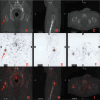Phosphaturic Mesenchymal Tumor of the Greater Trochanter: A Case Report
- PMID: 39493128
- PMCID: PMC11530255
- DOI: 10.7759/cureus.70721
Phosphaturic Mesenchymal Tumor of the Greater Trochanter: A Case Report
Abstract
This is the case of a 56-year-old Hispanic male with a history of multiple fractures and electrolyte abnormalities, including hypophosphatemia and phosphaturia. Physical examination, imaging studies, and laboratory workup may have suggested the presence of a phosphaturic mesenchymal tumor (PMT) causing osteomalacia. The patient underwent surgery for en bloc tumor removal, and the histopathological analysis confirmed the presence of neoplastic cells consistent with PMT with minimal immunohistochemical positivity to S100 protein, which is atypical for this type of tumor. This case highlights the challenges in diagnosing PMTs due to their rarity and variable presentation. It emphasizes the importance of considering PMT in the differential diagnosis for unexplained hypophosphatemia and osteomalacia-like symptoms, especially in persistent disease after parathyroidectomy for presumed primary hyperparathyroidism. The atypical immunohistochemical profile observed in this case contributes to the growing body of knowledge about the heterogeneity of PMTs and underscores the need for comprehensive diagnostic approaches in suspected cases.
Keywords: hypophosphatemia; phosphaturia; phosphaturic mesenchymal tumor; s100 protein; tumor induced osteomalacia.
Copyright © 2024, Bibiloni Lugo et al.
Conflict of interest statement
Human subjects: Consent was obtained or waived by all participants in this study. Conflicts of interest: In compliance with the ICMJE uniform disclosure form, all authors declare the following: Payment/services info: All authors have declared that no financial support was received from any organization for the submitted work. Financial relationships: All authors have declared that they have no financial relationships at present or within the previous three years with any organizations that might have an interest in the submitted work. Other relationships: All authors have declared that there are no other relationships or activities that could appear to have influenced the submitted work.
Figures





References
-
- Phosphaturic mesenchymal tumors: a review and update. Folpe AL. https://doi.org/10.1053/j.semdp.2019.07.002. Semin Diagn Pathol. 2019;36:260–268. - PubMed
-
- Phosphaturic mesenchymal tumors: rethinking the clinical diagnosis and surgical treatment. Liu Y, He H, Zhang C, Zeng H, Tong X, Liu Q. https://doi.org/10.3390/jcm12010252. J Clin Med. 2022;12:252. - PMC - PubMed
-
- Phosphaturic mesenchymal tumor (PMT): exceptionally rare disease, yet crucial not to miss. Ghorbani-Aghbolaghi A, Darrow MA, Wang T. https://doi.org/10.4322/acr.2017.031. Autops Case Rep. 2017;7:32–37. - PMC - PubMed
-
- 'Rachitic rosary sign' and 'tie sign' of the sternum in tumour-induced osteomalacia. Chakraborty PP, Bhattacharjee R, Mukhopadhyay S, Chowdhury S. https://doi.org/10.1136/bcr-2016-214766 BMJ Case Rep. 2016;2016:0. - PMC - PubMed
-
- Clinical, histopathologic, subtype, and immunohistochemical analysis of jaw phosphaturic mesenchymal tumors. Li D, Zhu R, Zhou L, Zhong D. https://doi.org/10.1097/MD.0000000000019090 Medicine (Baltimore) 2020;99:0. - PMC - PubMed
Publication types
LinkOut - more resources
Full Text Sources
Research Materials
